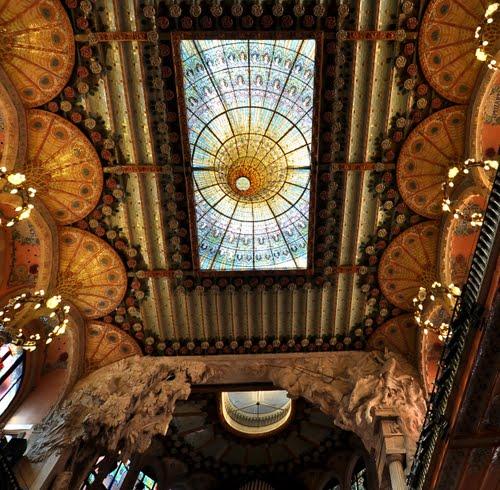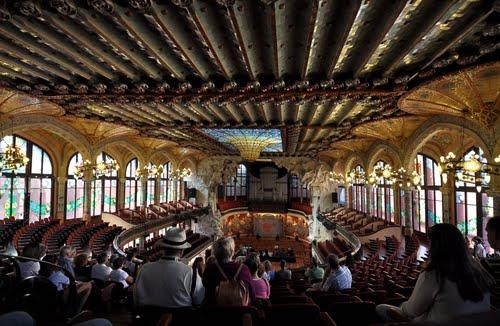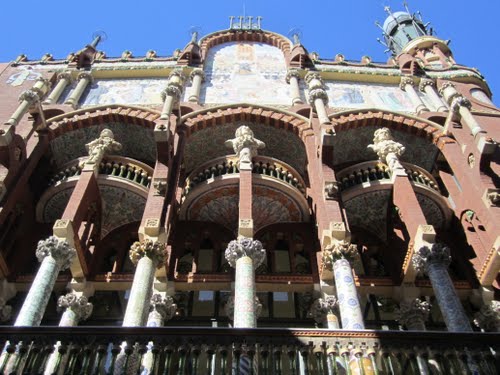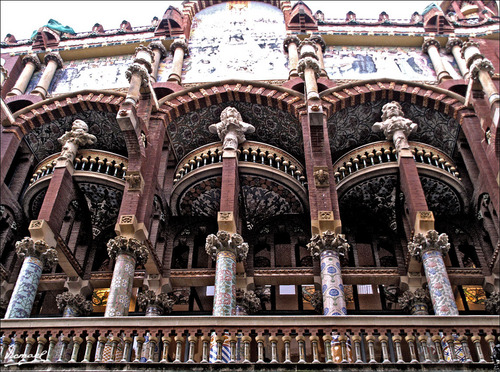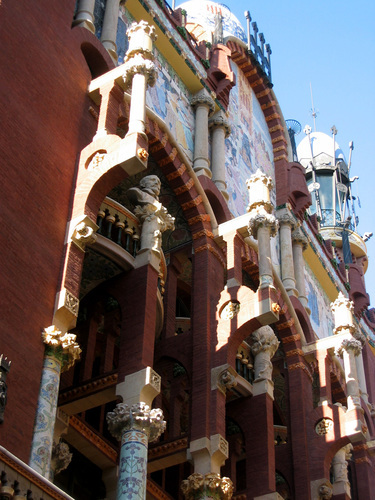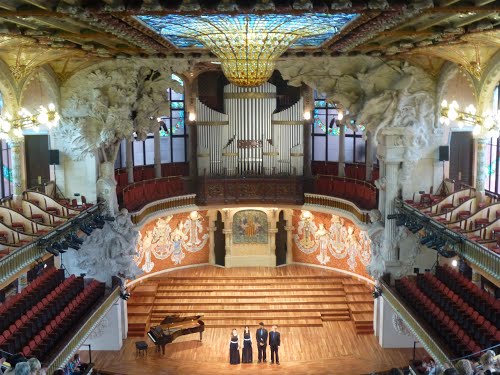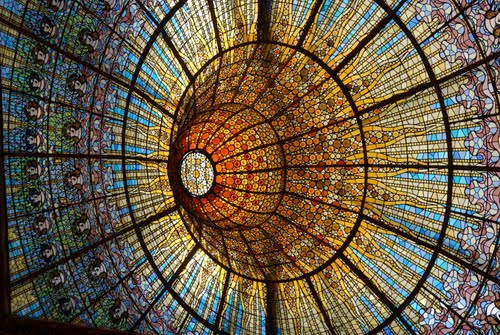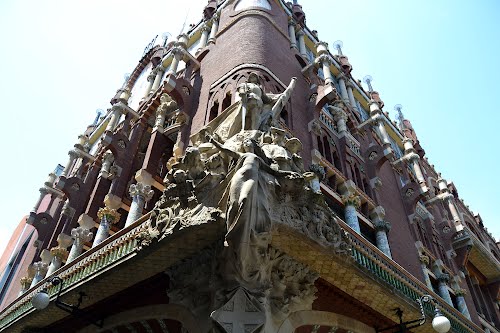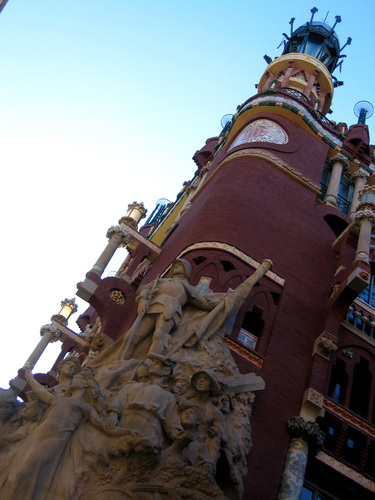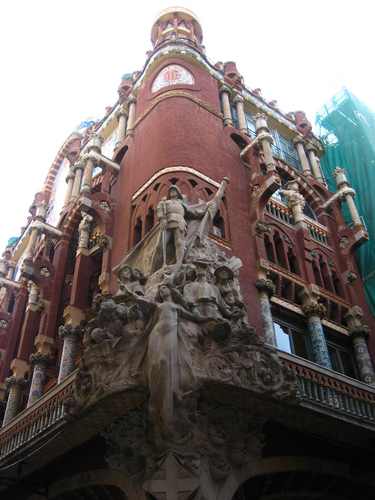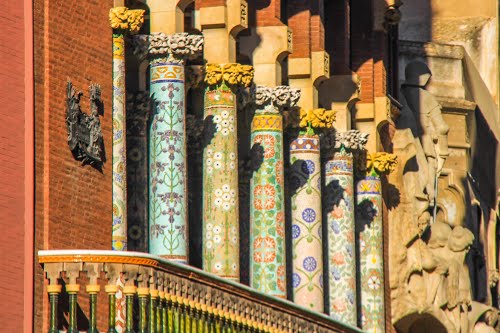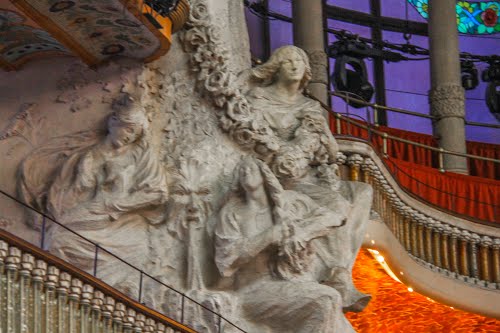The Palace of Catalan Music is a concert hall in Barcelona, Catalonia, Spain. Designed in the Catalan modernista style by the architect Lluis Domenech i Montaner, it was built between 1905 and 1908 for the Orfeo Catala, a choral society founded in 1891 that was a leading force in the Catalan cultural movement that came to be known as the Renaixenca. It was inaugurated February 9, 1908.
The project was financed primarily by the society, but important financial contributions also were made by Barcelona's wealthy industrialists and bourgeoisie. The Palau won the architect an award from the Barcelona City Council in 1909, given to the best building built during the previous year. Between 1982 and 1989, the building underwent extensive restoration, remodeling, and extension under the direction of architects Oscar Tusquets and Carles Diaz. In 1997, the Palau de la Musica Catalana was declared a UNESCO World Heritage Site along with Hospital de Sant Pau. Today, more than half a million people a year attend musical performances in the Palau that range from symphonic and chamber music to jazz and Canco.
Building
Location
The Palau is located in the corner of a cramped street, Carrer Palau de la Musica, and Carrer de Sant Pere Mes Alt, in the section of old Barcelona known as Casc Antic. Most of the other prominent modernista buildings, those designed by Antoni Gaudi, for example, are located in the chic 19th-century extension of the city known as the Eixample.
Design
The design of the Palau is typical of Catalan modernism in that curves predominate over straight lines, dynamic shapes are preferred over static forms, and rich decoration that emphasizes floral and other organic motifs is used extensively. In contrast to many other buildings built in the modernisme style, however, it must also be said that the design of the Palau is eminently rational. It pays strict attention to function and makes full use of the most up-to-date materials and technologies available at the beginning of the 20th century.
The wealthy citizens of Barcelona, who were becoming ever more sympathetic to the Renaixenca at the time the Palau was built, asked its architect for building materials and techniques that symbolized the Catalan character. In response, he commissioned and gave great creative freedom to a variety of local artisans and craftsmen to produce the fabulous ornamentation, sculpture, and decorative structural elements for which the Palau is famous.
Facade
The rich decoration of the facade of the Palau, which incorporates elements from many sources, including traditional Spanish and Arabic architecture, is successfully married with the building's structure. The exposed red brick and iron, the mosaics, the stained glass, and the glazed tiles were chosen and situated to give a feeling of openness and transparency. Even Miguel Blay's massive sculptural group symbolizing Catalan music on the corner of the building does not impede the view into or out from the interior.
Two colonnades enjoy a commanding position on the second-level balcony of the main facade. Each column is covered uniquely with multicolored glazed tile pieces in mostly floral designs and is capped with a candelabrum that at night blazes with light. Above the columns are large busts of Giovanni Pierluigi da Palestrina, Johann Sebastian Bach, and Ludwig van Beethoven on the main facade and Richard Wagner on the side. The top of the main facade is graced by a large allegoric mosaic by Lluis Bru that represents the members of the Orfeo Catala, but it is impossible to see it clearly from the narrow street below.
Entrance
Originally, guests entered the Palau from the street through two arches supported by thick pillars that opened into the vestibule. The former ticket windows, which are located in the center pillar, are beautiful concentric arches adorned with floral mosaics of various materials created by Lluis Bru.
Vestibule, staircases, and foyer
The ceiling of the vestibule is decorated with glazed ceramic moldings that are arranged in the shape of stars. From the vestibule, on the left and right, grand marble staircases ascend from between crowned lamps on columns to bring visitors to the second floor. The balustrades of the staircases, also marble, are supported by unusual transparent yellow glass balusters. The underside of the staircases is covered with tiles that form gleaming canopies on either side of the vestibule.
Today, guests generally enter the Palau through the foyer, which was created in the renovations of Tusquets and Diaz from what originally were the headquarters of the Orfeo Catala. The large space of the foyer is more soberly decorated than the rest of the Palau, but the wide exposed brick arches with their marvelous glazed green, pink, and yellow ceramic flowers recapitulate the ornamentation of the rest of building. The foyer features a large counter where tapas and beverages can be served to concert-goers or visitors who are touring the building. The bar is situated between massive pillars of brick and is illuminated from behind by expansive stained-glass panes that are suspended above it. A glass case in the foyer displays the Orfeo Catala's banner, which bears its crest embroidered on fabric in the modernisme style.
Lluis Millet hall
The Lluis Millet hall is a salon located on the second floor of the Palau that is named after one of the founders of the Orfeo Catala. The hall is a popular gathering place for concert-goers and also serves as a teaching area for visitors touring the building. From floor to ceiling the hall is two stories high and affords views of the intricate mosaics on the two rows of columns outside its windows that are much better than those available from the street.
Concert hall
The concert hall of the Palau, which seats about 2,200 people, is the only auditorium in Europe that is illuminated during daylight hours entirely by natural light. The walls on two sides consist primarily of stained-glass panes set in magnificent arches, and overhead is an enormous skylight of stained glass designed by Antoni Rigalt whose centerpiece is an inverted dome in shades of gold surrounded by blue that suggests the sun and the sky.
The architectural decoration in the concert hall is a masterpiece of creativity and imagination, yet everything has been carefully considered for its utility in the presentation of music.

